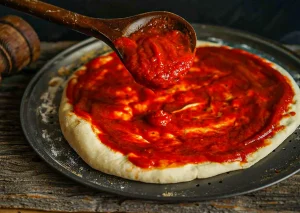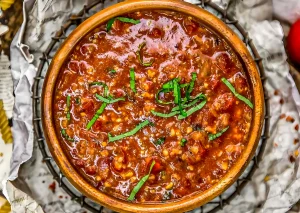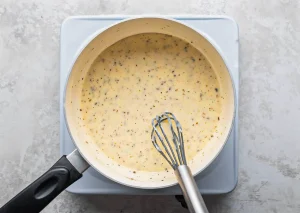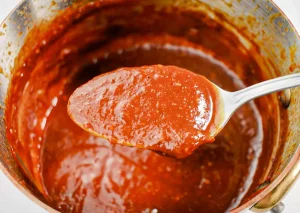The secret to an unforgettable pizza lies not just in the toppings, but in the sauce. Homemade pizza sauce elevates your pizza experience by adding freshness, depth, and personality. Whether you’re crafting a classic Margherita or experimenting with more adventurous flavors, the sauce is the unsung hero of every great pie.
Making pizza sauce at home offers numerous advantages: you control the ingredients, it’s healthier (no preservatives or unnecessary sugars), and it’s more affordable than buying pre-made sauces.
Plus, you can customize the sauce to match your taste—whether you want something tangy, spicy, creamy, or smoky. In this article, we’ll explore five distinct homemade pizza sauce recipes that suit every preference.
From the bright, fresh flavors of a Margherita-style sauce to the spicy kick of a zesty arrabbiata, you’ll find the perfect sauce to match your pizza mood. Let’s dive in!
Recipe Selection Criteria
When curating these pizza sauce recipes, we considered several important factors. Taste, of course, is paramount, but we also wanted to ensure the sauces were versatile, easy to prepare, and made with ingredients you likely already have in your pantry.
Additionally, we included options for various dietary preferences: vegan, keto-friendly, and those who crave a little spice in their life.
The selected sauces cater to a wide variety of flavor profiles—whether you’re in the mood for something fresh and tangy, or rich and indulgent.
We’ve made sure each sauce offers something different, so you can experiment and find the perfect match for your favorite pizza.
1. Classic Margherita Pizza Sauce
Flavor Profile: Fresh, tangy, and herbaceous.
A true classic, this Margherita pizza sauce is simple yet packed with flavor. Its foundation is the humble tomato, paired with aromatic garlic and herbs. This sauce is a perfect representation of the beauty of fresh, quality ingredients.
Key Ingredients:
- Canned crushed tomatoes (preferably San Marzano)
- Olive oil
- Fresh garlic (minced)
- Dried oregano
- Fresh basil
- Salt & pepper
Preparation Steps:
- In a medium bowl, combine the crushed tomatoes with olive oil.
- Add the minced garlic and dried oregano to infuse the sauce with warmth and fragrance.
- Stir in freshly chopped basil for a burst of freshness.
- Season with salt and pepper, tasting as you go to balance the flavors.
- Let the sauce sit for at least 30 minutes to allow the herbs to meld with the tomatoes. For the best flavor, you can refrigerate it for a few hours before using it.
Best Pairing Suggestions: This sauce is ideal for a Margherita pizza—top it with fresh mozzarella, more basil, and a drizzle of olive oil before baking. You can also use it as a base for any simple veggie pizza or a classic cheese pizza.
Tip: If you want an extra depth of flavor, try roasting the garlic before adding it to the sauce for a sweeter, caramelized note.
2. Spicy Arrabbiata Sauce
Flavor Profile: Bold, spicy, and garlicky.
For those who love heat, the Arrabbiata sauce is a must-try. This fiery Italian classic is packed with garlic, red pepper flakes, and a rich tomato base. It’s the perfect sauce for anyone who likes a kick in their pizza without overwhelming the other ingredients.
Key Ingredients:
- Canned tomato puree
- Olive oil
- Fresh garlic (minced)
- Red pepper flakes
- Fresh parsley (optional)
- Salt & pepper
Preparation Steps:
- Heat olive oil in a medium saucepan over medium heat. Add minced garlic and sauté until fragrant.
- Stir in the tomato puree and red pepper flakes. Simmer for 15-20 minutes, stirring occasionally, until the sauce thickens slightly.
- Taste and adjust the heat level by adding more red pepper flakes if desired.
- Stir in fresh parsley just before removing the sauce from the heat for a pop of color and a refreshing flavor.
Best Pairing Suggestions: This sauce is ideal for a spicy pepperoni pizza, a sausage pizza, or even a vegetarian pizza with mushrooms, olives, and fresh bell peppers. The spicy kick balances out rich toppings perfectly.
Tip: If you want to make the sauce extra smoky, add a pinch of smoked paprika or chipotle powder.
3. Creamy White Pizza Sauce
Flavor Profile: Rich, creamy, and indulgent.
If you’re craving something creamy and luxurious, look no further than this white pizza sauce. With its base of heavy cream and Parmesan, this sauce is smooth, velvety, and utterly decadent. It’s a perfect contrast to the crispy pizza crust.
Key Ingredients:
- Heavy cream
- Butter
- Fresh garlic (minced)
- Parmesan cheese (grated)
- Fresh nutmeg
- Salt & pepper
Preparation Steps:
- Melt butter in a saucepan over medium heat. Add the minced garlic and sauté until it becomes fragrant and golden.
- Pour in the heavy cream and bring to a simmer. Stir occasionally.
- Slowly whisk in the grated Parmesan cheese, allowing it to melt into the cream.
- Add a pinch of freshly grated nutmeg to deepen the flavor.
- Season with salt and pepper, tasting as you go to ensure balance.
Best Pairing Suggestions: This sauce is perfect for a white pizza topped with spinach, ricotta, artichokes, or even chicken. It’s rich enough to complement savory ingredients without overwhelming them.
Tip: If you’re looking for a lighter version, you can substitute the heavy cream with half-and-half or a non-dairy cream alternative for a vegan-friendly option.
4. Vegan Pizza Sauce
Flavor Profile: Fresh, tangy, and herbaceous.
This vegan pizza sauce is bursting with bright flavors from fresh tomatoes and herbs. It’s a fantastic option for plant-based diets but remains a delicious choice for everyone, no matter their dietary preferences.
Key Ingredients:
- Canned diced tomatoes
- Olive oil
- Fresh garlic (minced)
- Fresh basil
- Lemon juice (for brightness)
- Salt & pepper
Preparation Steps:
- Blend the canned diced tomatoes in a blender or food processor until smooth.
- In a bowl, mix the tomato puree with olive oil, garlic, basil, and a squeeze of fresh lemon juice.
- Season with salt and pepper to taste.
- Let the sauce sit for at least 30 minutes to allow the flavors to meld together.
Best Pairing Suggestions: This light and zesty sauce pairs wonderfully with a vegan veggie pizza. Top it with fresh mushrooms, spinach, olives, and artichokes for a wholesome, plant-based meal.
Tip: For a smoky touch, consider adding a dash of smoked paprika or roasted red peppers.
5. Smoky BBQ Pizza Sauce
Flavor Profile: Smoky, sweet, and tangy.
If you’re looking for something a little different, a BBQ pizza sauce adds a fun twist to your traditional pizza. This sauce offers a smoky depth with a balance of sweetness and tang—perfect for those who like their pizza with a barbecue flair.
Key Ingredients:
- BBQ sauce (your favorite brand)
- Tomato paste
- Smoked paprika
- Garlic powder
- Honey (for sweetness)
Preparation Steps:
- In a bowl, combine your favorite BBQ sauce with tomato paste. Stir in smoked paprika, garlic powder, and a touch of honey for sweetness.
- Mix well and taste, adjusting the sweetness and smokiness to your liking.
- Let the sauce sit for 10-15 minutes to allow the flavors to develop.
Best Pairing Suggestions: This smoky BBQ sauce is perfect for a BBQ chicken pizza, pulled pork pizza, or even a bacon and onion pizza. It’s an excellent choice for pizza lovers who enjoy a hearty, flavorful base.
Tip: If you want a touch more heat, add a little cayenne pepper or chili powder for an extra kick.
Key Notes
Course: Sauce
Cuisine: Italian
Keyword: Homemade Pizza Sauce
Prep Time: 10-15 minutes
Cook Time: 0-30 minutes (depending on the recipe)
Total Time: 10-45 minutes
Servings: 8-10 servings
Calories: 60-120 per serving (varies by recipe)
Tips for Storing and Using Homemade Pizza Sauce
Homemade pizza sauce is easy to store, and having extra batches in your fridge or freezer means you’ll be ready for pizza night at a moment’s notice.
- Refrigeration: Store leftover pizza sauce in an airtight container in the fridge for up to 5 days. Stir before using, as the sauce may thicken over time.
- Freezing: For longer storage, pizza sauce can be frozen for up to three months. Ice cube trays are an excellent way to freeze sauce in portions, making it easy to thaw just what you need.
- Reheating: Gently reheat your sauce in a saucepan over low heat, stirring occasionally. If frozen, allow it to thaw overnight in the fridge or heat directly from frozen in the microwave.
Homemade pizza sauce can also be used in pasta dishes, lasagna, or as a dip for breadsticks and garlic knots.
Conclusion
Making your own pizza sauce opens up a world of possibilities. From the classic simplicity of a Margherita sauce to the bold heat of an arrabbiata, there’s no shortage of delicious flavors to explore. Homemade pizza sauce is not only easy to prepare but also gives you the flexibility to experiment with different ingredients and create the perfect pizza every time.
Which one will you try first? Let us know in the comments, and share any of your own favorite pizza sauce creations. Happy cooking, and even happier eating!
Author
-
The Los Foodies Magazine content team is dedicated to showcasing New Mexico’s food culture through stories, recipes, events, and local business features. They create engaging content that connects readers with the chefs, restaurants, and flavors that define the community.
View all posts Los Foodies Magazine Content Team












